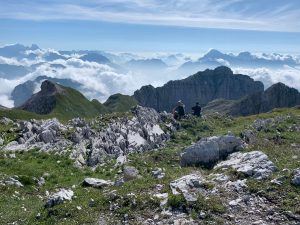

The Alta Via 1 is Italy’s premier long-distance multi-day trek. Stretching from north to south across the Dolomites, this trail may inspire feelings of contentment and tranquility. But these imposing mountains hold a dark past full of death and warfare.
On May 23rd, 1915, the Kingdom of Italy entered World War I in alliance with the Triple Entente, also known as the Allies. Previously neutral, Italy was largely motivated to reunite Italian-speaking areas into the Kingdom of Italy. Their strategic goal was to push into the Badia Valley, where they would have access to railway infrastructure.
The Italian forces, also known as The Alpini, quickly regained Cortina d’Ampezzo and pushed back Austro-Hungarian forces, the Kaiserjaeger, who strategically positioned themselves high in the mountains at various positions establishing the war front in the Dolomites.
One of these positions was at the summit of the Piccolo (Small) Lagazuoi (near present-day Rifugio Lagazuoi). With the Austro-Hungarian troops so well positioned on top of mountains, there were limited options for attack. The Italian troops strategized to blast tunnels underneath the positions of the Austro-Hungrian troops, in order to destroy their posts and gain their positions. This strategy launched a type of mine warfare never seen before.


Warfare in the rugged and hostile terrain of the Dolomites led both militaries to enlist skilled and experienced mountaineers, many of whom had previously enjoyed the mountains recreationally with their now-enemies. It is rumored that despite the brutal warfare, Italian and Austro-Hungarian soldiers gathered from time to time for a friendly card game.
While the warfare was brutal, it was really the mountains that were deadly. This was especially true during the harsh winters. More soldiers lost their lives to the mountains (exposure to cold, avalanches, etc.) than they did to their enemy.
The Italians slowly progressed up the mountain and set up a small emplacement on the Martini ledge, with buildings both dug into into the mountain and hanging off the edge of the forbidding cliffs. This outpost included an artillery kitchen, barracks, a canteen, and a medical facility.
In 1916, the rock of Piccolo Lagazuoi changed forever, as troops on both sides began launching mine attacks. The Italians sought to gain the summit, while the Austrians attempted to push the Italians down from the Martini Ledge.
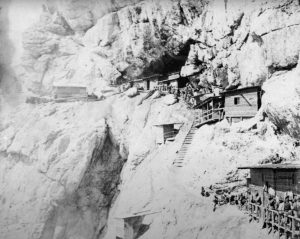

Although the Allies were eventually victorious in World War I, the Italians did lose their battle on the Dolomites front. After defeat at the Battle of Caporetto near the town of Kobarid in modern-day Slovenia, the Italians retreated on November 1st 1917, and both Austrian and Italian posts in the dolomites were deserted.
Today, the Alta Via 1 is a utopia for hikers, who often unknowingly, are retracing the footsteps of hardened soldiers. Here’s a summary of some of the historic sites along the trail.
Fodara Vedla and Pederü
Hikers enter war territory as early as Rifugio Fodara Vedla, where former barracks for the Kaiserjaeger were located. Down in the valley, a military camp was at the location of Rifugio Pederü, and the building itself served as the barracks.
Barracks on Passo di Limo
Hikers will pass the remains of old barracks not far from Passo di Limo after ascending from Rifugio Fanes. These barracks are at the location of a former wooden structure that was built by the Austrians during World War I. Passo di Limo was to be the second line of defense, in the case that the Italians broke through the first defense line. The barracks you see today, the former Mario Feruglio barracks, were built and used by the Italian 6th Alpine Regiment after the war.
Memorial Chapel at Rifugio Scotoni
There is a chapel next to Rifugio Scotoni that was built to commemorate the soldiers that fell not only to warfare, but also to harsh conditions.
Ruins on the way to Lagazuoi
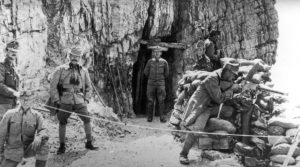

The Austro-Hungarian’s main supply route to the Lagazuoi front was via a material ropeway that ran from Capanna Alpina to where Rifugio Scotoni stands today, and then further up to Lake Lagazuoi. The trail from Lake Lagazuoi to Forcella Lagazuoi follows the old supply road. There are several ruins of former warehouses and housing for the cableway staff along the way.
On the ascent from Forcella Lagazuoi to Rifugio Lagazuoi, you’ll pass two Austro-Hungarian emplacements.
Lagazuoi Tunnels
While there are many tunnels on the Piccolo (Small) Lagazuoi, the most accessible and best known, are the tunnels that descend from the Lagazuoi gondola station. This is an alternate descent route from Rifugio Lagazuoi to Passo Falzarego.
These tunnels were built by the Italian troops, and they are steep, dark and low. There is a cable to hold throughout, and some may even prefer the additional security of a via ferrata set (recommended for children, but there is no exposure, and almost everybody will be comfortable without the extra security). Headlamps are essential, and a helmet is strongly recommended. Helmets and via ferrata sets can be rented at the base of the gondola station (or you can arrange with Rifugio Lagazuoi in advance to have them available for pick-up at the hut). If you don’t have a helmet, wear a padded winter hat or hood over your head. The ceiling is low, and you are guaranteed to hit your head more than once.
Gasser Depot
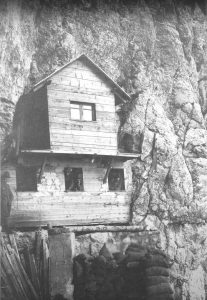

The Gasser Depot does not lie directly on the Alta Via 1, but it is worth a visit if you have some extra time in the area around Rifugio Lagazuoi. Built in July 1916, the Gasser was home to a small village occupied by the Austro-Hungarian forces, mostly made up of caves in the rocks. The depot was attacked by Italian forces in October 1916, who destroyed a guard post and captured some Austro-Hungarians. Otherwise, the Gasser Depot was controlled by the Austro-Hungarians until the posts in the Dolomites were abandoned in November 1917.
The Gasser Depot is about 2.3 km. (1.4 miles) from Rifugio Lagazuoi and may take around an hour to reach (one way). It can be reached by descending from Rifugio Lagazuoi to Forcella Lagazuoi, and then continuing on Trail 401 to Forcella Travenanzes. At Forcella Travenanzes turn left onto trail 1020.
Cinque Torri
The ridge of the Cinque Torri served as artillery headquarters and as a second defense line for the Alpini. It was also a fantastic surveillance point that allowed the Italians to observe all movement on the other side. In addition to heavy artillery, the Italians lined the ridge with floodlights, illuminating the movements of the Kaiserjaeger throughout the night.
There was an Italian miliary camp where Rifugio Averau stands today. A critical observatory was located on top of Mount Averau, with a small cabin where an electric spotlight was used for communication with the troops on the other side of Falzarego Pass using morse code.
The Cinque Torri region is part of the World War I open air museum, and signboards can be found with marked trails to the various places of interest.
Watch this video for a further understanding of the warfront.
Via Ferratas
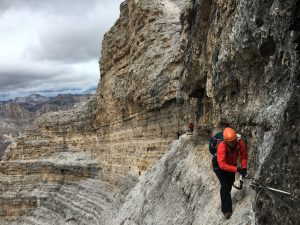

Via ferratas are climbing routes that are permanently secured by steel cables that have been installed into the mountains. Although they didn’t originate in World War I, they gained their fame due to their construction and use by soldiers to navigate through the rugged and dangerous terrain the Dolomites had to offer. Some of these via ferratas are still used today by recreationalists seeking exposure and thrills (don’t worry…they have since been maintained). The via ferratas in the Lagazuoi and Cinque Torri region; however, were all constructed after the war. They require specific gear and skills, as well as a solid head for heights. Anyone without rock climbing experience should hire a guide.
Kaiserjägersteig
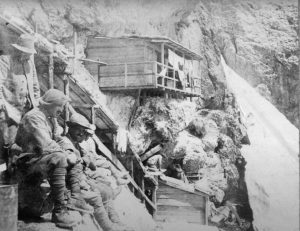

The Kaiserjägersteig is an easy via ferrata that allows you to retrace the steps of the Austro-Hungarian soldiers as they attempted to push the Italians off the Martini Ledge. Although this is rugged terrain and there is some exposure, the availability of cables makes this route suitable for children with the added security of a via ferrata set (available for rent at the base of the gondola station). Bring a headlamp and helmet, so you can explore the tunnels.
The Kaiserjägersteig makes a great loop with the Lagazuoi Tunnels. If you are coming from Rifugio Lagazuoi, descend the tunnels and continue down toward the gondola station once you exit them. Turn right shortly before the gondola station to follow the Kaiserjägersteig. If you are coming from Passo Falzarego, hike toward the mountain behind the gondola station and look for the sign to the Kaiserjägersteig leaving to the left. Once at the top, head to Rifugio Lagazuoi and descend via the tunnels back to the pass.
Via Ferrata degli Alpini
This via ferrata first opened in 2008, and was not used by soldiers during World War I. However, it starts near Caserna Guiera Alpini, former Italian Barracks and tops out a Col de Bois, an Italian emplacement on the front lines, armed with machine guns.
Via Ferrata Giovanni Lipella
This via ferrata was first built in 1967 by the Cortina guides and the local alpine club. It was not used during the war. But, it is dedicated to the memory of Giovanni Lipella, a Gold Medal for Military Valor. A member of the Alpini, he died in combat in June 1918. A note in his desk drawer at a bank in Brescia that was found after his death read, “If it happens that I never come back, my will is this: Long live Italy.”
Via Ferrata Tomaselli
This via ferrata was built in 1969 and dedicated to Captain Francesco Tomaselli of the Alpini. He held two medals for military valor, was a mountain lover, and participated in an expedition to the north pole.
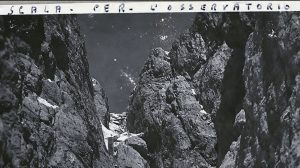

Via Ferrata Averau
Mount Averau was a critically important observatory for the Italians during the war. From the summit, they not only illuminated the Lagazuoi mountainside, allowing them to track the movement of Austrian troops, but they also used their perch to communicate with the Italians located on and in the areas surrounding the Martini Ridge. This communication was done using an electric spotlight and morse code.
The soldiers used a series of wooden ladders to reach the summit of Mount Averau, and not the via ferrata that is installed today. But an adventure to the summit on today’s easy via ferrata still leads to that ever-so-import perch on the summit of the mountain.
Resources
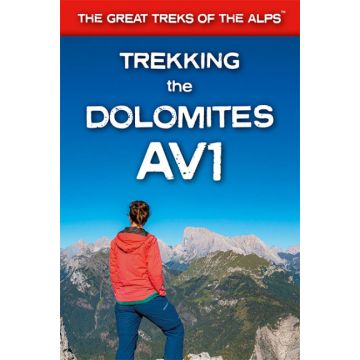

Our primary resource for this article is: https://lagazuoi.it/EN/Discover-History-page3-The-Great-War-in-Ampezzo
Video – Trenches at 10,000 feet https://www.youtube.com/watch?v=oTn5aTy38lk&t=227s
Video – The Great War on the Alps Episode 1 https://www.youtube.com/watch?v=b9COy_fm0Jg
Video – The Great War on the Alps Episode 2 https://www.youtube.com/watch?v=mjeH7NLBvyY
Video – The Great War on the Alps Episode 3 https://www.youtube.com/watch?v=g_tFIXXZE7I
Video – The Great War on the Alps Episode 4 https://www.youtube.com/watch?v=7KT9JxGrizQ
Video – The Great War on the Alps Episode 5 https://www.youtube.com/watch?v=Hyio52H1Px8
Video – The Great War on the Alps Episode 6 https://www.youtube.com/watch?v=eknP5hCP0iE
Video – 5 The Italian Tunnels on the Presummit https://www.youtube.com/watch?v=zJ-7-w6vkas
Video – 4 Die Stollen und Minen des Kleinen Lagazuoi https://www.youtube.com/watch?v=s7JbuF4zMtk
Video – ITALIAN DOLOMITES | THE ROAD OF THE 52 TUNNELS https://www.youtube.com/watch?v=zTdI9DPWzH8
Video – The Edge of the Abyss – Mountain Warfare On the Italia Front https://www.youtube.com/watch?v=5JI-UC_Osg8
Video – The Great War on the Little Lagazuoi https://www.youtube.com/watch?v=tufF3kgCtf0
Video – Lagazuoi Stollen, Galleria del Lagazuoi, Dolomiten https://www.youtube.com/watch?v=1l0tMOMc8ug
Video – 2 Die Kriegsfront am Lagazuoi https://www.youtube.com/watch?v=WfpPSsRlUNs
Video – 3 Das Martini Felsband des Kleinen Lagazuoi https://www.youtube.com/watch?v=80Gh8_jJYaw
Video – Alpinisteig https://www.youtube.com/watch?v=ZgK3Hu2kpTM
Averau History https://www.rifugioaverau.it/en/first-world-war/history-and-features/
